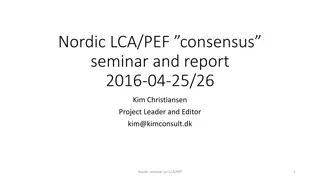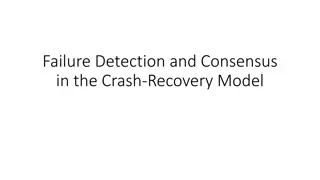SOON Consensus Working
The options for fetal growth charts - universal vs. customized, statistical approaches, and the debate on using universal charts. Learn how to select the best chart for monitoring fetal growth based on physiological factors and statistical analysis
Download Presentation

Please find below an Image/Link to download the presentation.
The content on the website is provided AS IS for your information and personal use only. It may not be sold, licensed, or shared on other websites without obtaining consent from the author.If you encounter any issues during the download, it is possible that the publisher has removed the file from their server.
You are allowed to download the files provided on this website for personal or commercial use, subject to the condition that they are used lawfully. All files are the property of their respective owners.
The content on the website is provided AS IS for your information and personal use only. It may not be sold, licensed, or shared on other websites without obtaining consent from the author.
E N D
Presentation Transcript
SOON Consensus Working Group on Fetal Growth How to choose the right chart? May-1st, 2019
Universal vs. Customized Charts Customized charts Race specific charts Universal charts E.g., GROW (Gardosi) E.g., NICHD, WHO E.g., Intergrowth-21 Should adjust for race/country Adjust for all PHYSIOLOIC factors affecting fetal growth: All fetuses have the same genetic growth potential Race Maternal height Maternal weight Parity Fetal sex
10th percentile of various references 3000 10th% 2500 Intergrowth-21 (EFW) NICHD (EFW, white) 2000 Weight (gr) WHO (EFW) 1500 1000 500 0 22 24 26 28 30 32 34 36 38 40 Kiserud et al., PlosOne Jan-2017 Gestational age (weeks)
To POOL or not to POOL That is the question
IG-21st: criteria to pool data ...differences are not large enough to not allowing pooling them together ?Differences in AC & EFW
IG-21 WHO
Should we use Universal Charts? Proponents Simple Comparison between different populations (indicator of public health) WHO Universal charts are used to monitor childhood growth Opponents 1. An average chart may lead to over- & under-diagnosis of IUGR 2. Depends on an arbitrary decision of which sites are included 3. Even if skeletal indices (HC) are similar, it is fetal weight and AC (not HC) that are associated with FGR and stillbirth, and they are likely to be quite different between countries 4. Intrauterine growth childhood growth Shorter time frame (13-14 weeks) More severe consequences of delayed diagnosis of FGR
How to choose the best chart?
1. Statistical approach Find the chart that best matches the distribution of fetal weight in low risk pregnancies in your own population Expected Hadlock IG-21 WHO NICHD Kramer Proportion of EFW<3rd% Proportion of EFW<10th% Proportion of EFW>90th% Proportion of EFW>97th% ~3% ~10% ~10% ~3%
Rate of SGA<10% in Ontario (37-40w, low-risk, n=181,882) 25% 25% NICHD IG-21 20% 20% Rate of SGA (%) Rate of SGA (%) 15% 15% 13.1% 12.00% 10.0% 9.9% 10% 10% 6.4% 6.1% 4.6% 5% 5% 3.5% 0% 0% Overall White Asian Black Overall White Asian Black 25% 25% Hadlock WHO 20.7% 20% 20% Rate of SGA (%) Rate of SGA (%) 18.6% 16.5% 15.2% 14.6% 15% 15% 12.1% 11.9% 9.2% 10% 10% 5% 5% 0% 0% Overall White Asian Black Overall White Asian Black
Rate of SGA<10% in Ontario (37-40w, low-risk, n=181,882) 25% ~70,000 births /year in SOON Asians ~27% = ~19,000/year NICHD 20% Rate of SGA (%) NICHD Hadlock WHO 15% 13.1% 12.00% Rate of SGA in Asians 9.9% 16.5% 20.7% 10.0% 9.9% 10% 5% #of cases of SGA in Asians 1881 3135 3933 0% Overall White Asian Black 25% 25% Hadlock WHO 20.7% 20% 20% Rate of SGA (%) Rate of SGA (%) 18.6% 16.5% 15.2% 14.6% 15% 15% 12.1% 11.9% 9.2% 10% 10% 5% 5% 0% 0% Overall White Asian Black Overall White Asian Black
Rate of SGA <10th% - Sunnybrook data 30% Overall Preterm 25% 20% Rate of SGA (%) 15% 10% 5% 0% Hadlock IG21 WHO Kramer Brenner
Birthweight vs. U/S Based Chart 3000 10th% 2500 2000 Weight (gr) 1500 1000 500 0 22 24 26 28 30 32 34 36 38 40 Gestational age (weeks)
2. Outcome-based approach 5th% 3000 2500 2000 Weight (gr) 1500 Adverse outcome Stillbirth Neonatal death Neonatal morbidity Asphyxia 1000 500 0 22 24 26 28 30 32 34 36 38 40 Gestational age (weeks) No clear cut-off trade-off between detection rate and false-positive rate
Predictive accuracy of SGA<10% for unexplained in Sunnybrook (n=108) Hadlock IG-21 WHO Kramer Sensitivity (DR) Specificity PPV NPV LR+ LR- 61.1% 53.7% 63.0% 49.1% 88.1% 1.1% 99.9% 5.15 0.44 94.1% 2.0% 99.9% 9.16 0.49 85.7% 1.0% 99.9% 4.39 0.43 89.6% 1.0% 99.9% 4.72 0.57 WHO IG21
Summary 1. Choice of right chart has important implications 2. General agreement that US-based chart should be preferred over BW-based charts 3. Statistical validation (rate of SGA<10% ~=10%) 1. NICHD seems to be most suitable to Ontario 2. IG21 under-detects SGA (~5%) 3. Hadlock, WHO over-diagnose SGA in Asian, Black 4. Kramer under-detects SGA <37 weeks 4. Outcome-based validation No information re ethnicity cannot assess NICHD IG-21, Kramer SGA has lowest DR but highest specificity for stillbirth
DISCUSSION Pros Cons Old Hadlock Simple - used by most centers Over-diagnose SGA in non- white population Simple, excellent methodology, universal chart Optimal detection of SGA, North American IG-21 May under-detects IUGR NICHD Requires using race-specific chart Simple, excellent methodology, universal chart WHO Over-diagnose SGA in non- white population Consistent with neonatal assessment, Canadian Kramer Under-detects IUGR <37 weeks Cumbersome, time consuming Customized May improve detection rate & FPR
1. Which TYPES of charts are available?
AJOG 2016 Compare the performance of IG-21st and a customized standard in their local population Prospective data of 53,484 live birth >33 weeks (New Zealand) Statistical correlation 4.5% 11.6%
Correlation with outcome Composite outcome: Neonatal death NICU >48h Ventilation >4h 5-minutes Apgar <7 The INTERGROWTH-21st standard is not suitable for their population
Reference vs. Standard Charts E.g., Hadlock E.g., Kramer Reference Standard Descriptive (actual growth) ALL pregnancies Prescriptive (optimal growth) Only low risk pregnancies vs. 4000 4000 3500 3500 3000 3000 Weight (gr) Weight (gr) 2500 2500 10% 5% 3% 10% 2000 2000 1500 1500 1000 1000 500 500 24 26 28 30 32 34 36 38 40 Weeks 24 26 28 30 32 34 36 38 40 Weeks
Birthweight vs. Ultrasound-based Charts E.g., Hadlock E.g., Kramer Birthweight-based (newborn weight) Ultrasound-based (estimated fetal weight) vs. 3000 3000 2500 2500 Weight (gr) Weight (gr) 2000 2000 1500 1500 1000 1000 500 500 24 24 26 26 28 28 30 30 32 32 34 34 36 36 38 38 40 40 Weeks Weeks
10th percentile of various references Hadlock 1991 Ultrasound-based standard 3000 10th% Hadlock (EFW) 2500 Population N=392 Low-risk Mainly white women Huston, TX 2000 Weight (gr) 1500 Dating: US or clinical 1000 500 0 22 24 26 28 30 32 34 36 38 40 Hadlock et al., Radiology 1991 Gestational age (weeks)
10th percentile of various references Kramer 2001 Population-based reference Based on birth weight data in Canada (excluding ON) 1994-1996 3000 10th% Hadlock (EFW) Kramer (BW) 2500 2000 Weight (gr) N=676,605 1500 1000 500 0 22 24 26 28 30 32 34 36 38 40 Kramer et al., Pediatrics 2001 Gestational age (weeks)
Birthweight vs. Ultrasound-based Charts AJOG 2001 Fetal growth standards are more appropriate in predicting the impact of birth weight category on the risk of spontaneous preterm delivery than are neonatal growth standards. Arch Dis Child Fetal Neonatal 2007 Using fetal growth rather than birth weight standards gives a better indication of the incidence and role of FGR in neonatal disease. True North Imaging (Kramer): 2nd trimester - look mainly at the AC and not EFW
2. What are the best charts available?
10th percentile of various references Hadlock 1991 U/S standard most widely used 3000 10th% Hadlock (EFW) 2500 Population N=392 Low-risk Mainly white women Huston, TX 2000 Weight (gr) 1500 Dating: US or clinical 1000 500 0 22 24 26 28 30 32 34 36 38 40 Hadlock et al., Radiology 1991 Gestational age (weeks)
10th percentile of various references Intergrowth-21st 2014-2016 Goal: universal chart 3000 10th% Hadlock (EFW) 2500 Prospective int l longitudinal study Intergrowth-21 (EFW) 2000 N=4,321 women 8 low- and high- income countries VERY Low risk pregnancies Weight (gr) 1500 1000 Single international chart ( one size fits all ) 500 Lancet, 2014 0 22 24 26 28 30 32 34 36 38 40 Stirnemannet et al., UOG Dec 2016 Gestational age (weeks)
10th percentile of various references NICHD 2015 3000 10th% Hadlock (EFW) Prospective multi- center longitudinal study in the U.S. (2009-2013) 2500 Intergrowth-21 (EFW) 2000 N=2,334 Low risk pregnancies Weight (gr) NICHD (EFW, white) 1500 Race-specific standard curves 1000 500 0 22 24 26 28 30 32 34 36 38 40 Germaine et al., AJOG 2015 Gestational age (weeks)
10th percentile of various references WHO 2017 U/S based standard Goal: Universal chart 3000 10th% Hadlock (EFW) 2500 Prospective multi- center, international longitudinal study (10 centers) Intergrowth-21 (EFW) NICHD (EFW, white) 2000 Weight (gr) Population N=1,387 Low risk pregnancies WHO (EFW) 1500 1000 500 0 22 24 26 28 30 32 34 36 38 40 Kiserud et al., PlosOne Jan-2017 Gestational age (weeks)
10th percentile of various references Hadlock 1991 vs. WHO 2017 3000 10th% Hadlock (EFW) 2500 2000 Weight (gr) WHO (EFW) 1500 1000 500 0 22 24 26 28 30 32 34 36 38 40 Gestational age (weeks)
10th percentile of various references WHO 2017 Ultrasound-based standard Prospective multi- center, international longitudinal study (10 centers) 3000 10th% 2500 Intergrowth-21 (EFW) NICHD (EFW, white) 2000 Weight (gr) Population N=1,387 Low risk pregnancies WHO (EFW) 1500 Considerable differences between countries Curves may need to be adjusted to local population supports NICHD 1000 500 0 22 24 26 28 30 32 34 36 38 40 Kiserud et al., PlosOne Jan-2017 Gestational age (weeks)
Rate of LGA>90% in Ontario (37-40w, low-risk, n=181,882) 25% 25% NICHD IG21 20% 20% Rate of LGA (%) Rate of LGA (%) 15% 15% 10% 10% 5% 5% 0% 0% Overall White Asian Black Overall White Asian Black 25% 25% Hadlock WHO 20% 20% Rate of LGA (%) Rate of LGA (%) 15% 15% 10% 10% 5% 5% 0% 0% Overall White Asian Black Overall White Asian Black























